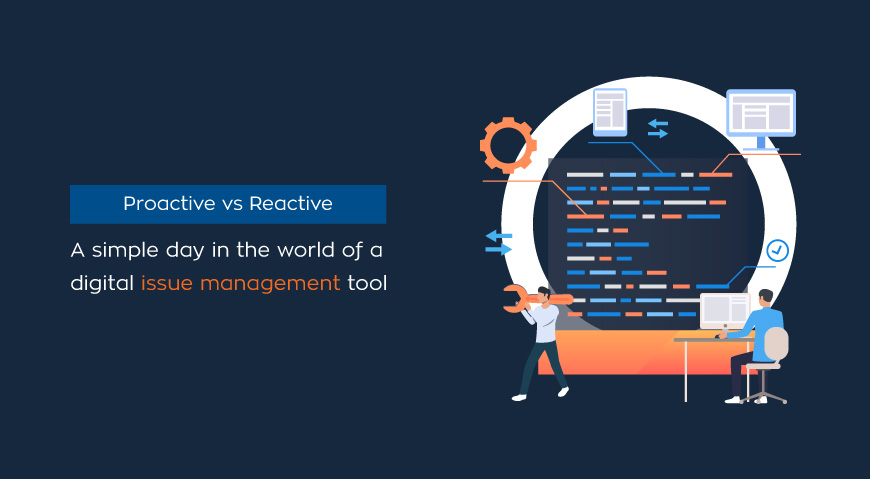- Posted by: blignos
- Published: 03-05-2023
- Category: Latest news
Proactive vs Reactive: A simple day in the world of a digital issue management tool
It can be said, that many abstract factors can be related to the needs arising in enterprises to use more and more sophisticated technologies. Just some of which may be the rapid pace of market growth and the imperative that this brings to businesses to adapt. As it seems, these speeds are not going to be normalized anytime soon, so the question easily arises: How simple is it to keep up with them?
One key way starts with getting businesses to create the right mechanisms to be proactive, rather than reactive and this leads us to the conclusion that identifying, acting and ultimately resolving incidents is a key step towards this direction.
5 reasons to move to an IM tool
Issue management software is designed to help organizations identify, track, and resolve issues. There are several reasons why organizations may need such a solution, some of which include:
- 1 Improved Communication: An issue management software - tool can help improve communication between different stakeholders involved in issue resolution. By providing a centralized platform for communication, stakeholders can stay up-to-date on the status of issues and collaborate more effectively to resolve them.
- 2 Faster Resolution Times: By providing real-time visibility into issue status and enabling collaboration between stakeholders, organizations can identify and resolve issues before they become major problems.
- 3 Improved Reporting and Analytics: Digital issue management solutions can provide organizations with detailed reporting and analytics capabilities, enabling them to identify trends and areas for improvement. This can help organizations proactively identify and address issues before they become major problems.
- 4 Regulatory Compliance: Many industries are subject to regulatory requirements related to issue management. Such solutions can help organizations ensure compliance with these requirements by providing a centralized platform for issue tracking and documentation.
Overall, a digital issue management solution can help organizations better manage and resolve the issues they face, leading to improved efficiency, faster resolution times, and better collaboration between stakeholders.
If you look closely, the common thread among the 4 on the list is the emphasis on the importance of organizations being able to be proactive and to fully understand and address problems before they become major. What are the key attributes to achieve this?
3 key IM features
QR-Patrol adds to the basic workforce management functions a comprehensive issue management tool with the following key features:
- 1 Real time issue management reporting: The software enables field workers to report incidents in real time through a user-friendly app environment, including details about the nature of the incident, location, and involved parties. This can help security teams to respond more effectively to incidents and take appropriate action to prevent future occurrences.
- 2 Workflow Management: The software provides tools for managing workflows and tasks related to physical security incidents. This includes assigning tasks to team members, tracking progress, setting deadlines, and prioritizing tasks. This feature can help streamline the incident response process and ensure that tasks are completed on time.
- 3 Reporting and Analysis: Features that help teams gain insights into incident data, such as incident frequency, response time, and root cause analysis composing a great proactive tool for teams to identify trends, make data-driven decisions, and improve overall security posture.
Proactive vs Reactive
Of course, an issue management software provides several advantages over the old ways of recording incidents, which typically involved using paper-based forms or spreadsheets. Some of the key differences are as follows:
- 1 Efficiency: An issue management software streamlines the process of recording incidents by providing a digital platform for creating, tracking, and managing incidents. This saves time and effort compared to the manual process of filling out paper forms or spreadsheets.
- 2 Proactive environmentally friendly solution: Each incident can be reported much faster using a real-time cloud-based system and the resolution process can be initiated at the same time of reporting, avoiding the use of pen & paper and any environmental impact this may have.
- 3 Collaboration: Multiple users may collaborate on incidents in real-time, which enables faster communication and more effective incident resolution. In contrast, vast spreadsheets and pan & paper ways of recording incidents relied on physical forms that could only be accessed by one user at a time.
- 3 Accessibility: It provides a centralized database of incident records that can be accessed from anywhere, as long as there is an internet connection while using traditional reporting ways, which often involved physical records that were stored in a single location and could be difficult to access.
- 3 Reporting and Analysis: Powerful reporting and analysis tools are provided, that can help organizations gain insights into their incident data, identify trends, and make data-driven decisions. Otherwise, the process of combining the data to produce insights can be both time-consuming and almost impossible most of the times.
If you enjoyed reading and for a creative discussion, feel free to contact us at success@qrpatrol.com or use our live chat (during working hours from 09:00 AM to 05:00 PM Greece time). Also, keep up with our blog for more.
Written by Michael Parmazis

















